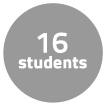This Course at MIT pages are part of the OCW Educator initiative, which seeks to enhance the value of OCW for educators.
Course Overview
This page focuses on the course 9.14 Brain Structure and Its Origins as it was taught by professor Gerald E. Schneider in Spring 2014.
This class is taken by MIT undergraduates with a special interest in learning about brain structure and how this structure underlies brain functions. The lectures are designed to teach key concepts as well as definitions of specialized terms used commonly by neuroscientists. Brain development and evolution are discussed to help students gain an understanding of why the central nervous systems of mammals (including humans) are put together the way they are.
Course Outcomes
Course Goals for Students
- To develop an interest in the brain and its functions, as well as its evolutionary and developmental origins
- To develop a broad understanding of mammalian functional neuroanatomy
- To gain familiarity with important neuroanatomical terminology
Possibilities for Further Study/Careers
Many students enrolled in this course go on to medical schools or to graduate schools. The latter most commonly enter neuroscience departments, but not all. Some pursue degrees in psychology, electrical engineering, and occasionally even the humanities or physics.
Dissecting a sheep’s brain helps students gain a better sense of the brain’s three-dimensional structure, which makes the course material more concrete.
—Gerald Schneider
Below, Professor Schneider describes various aspects of how he taught 9.14 Brain Structure and Its Origins.
Course and Resource Development
The content of the course has evolved over the past 14 years. It began with a focus on the anatomy of model systems used in neuroscience research and in studies of brain development. This focus was designed to help students learn the relevant neuroanatomy. Since then, I’ve introduced more and more comparative anatomy. I’ve also added more and more content about brain development.
My experiences teaching this course are what inspired me to write Brain Structure and Its Origins in Development and in Evolution of Behavior and the Mind (2014). The material for the book, just like the material for the class sessions, was prepared over my many years of teaching and involvement in laboratory research on brain anatomy and function. The book will be required reading for residential learners beginning in Spring 2015; it may also serve as a helpful resource for independent learners studying the material through OpenCourseWare.
Helping Students Learn Complex Material
One challenge students face in this course is learning a large number of new terms. I help students meet this challenge by providing them with online access to a glossary written especially for this course. I also define the most important terms in class, and ask questions during lectures to trigger students’ active participation.
Another strategy I use to help students learn the complex material in this course is to begin the discussion of brain structure with what we believe to be the simplest nervous systems of some of the first chordate animals—animals that preceded all the vertebrates. Detailed discussion of large primate brains occurs only in the final part of the class and textbook. I simplify diagrams to emphasize major concepts.
Dissecting a sheep’s brain helps students gain a better sense of the brain’s three-dimensional structure, which makes the course material more concrete. This is important because, during class sessions, we view and discuss many illustrations; relating the illustrations to a real brain is crucial. The dissection experience increases students’ ability to think dynamically about brain illustrations, and for this reason, I would prefer to include at least two dissection sessions instead of only one.
Curriculum Information
Prerequisites
9.01 Introduction to Neuroscience
Requirements Satisfied
9.14 can be applied toward a Bachelor of Science in Brain and Cognitive Sciences, but is not required.
Offered
Every spring semester
Assessment
The students' grades were based on the following activities:
 35% Quizzes, homework, and class participation
35% Quizzes, homework, and class participation 25% Midterm exam
25% Midterm exam 40% Final exam
40% Final examStudent Information

Breakdown by Year
1/3 sophomores, 1/3 juniors, 1/3 seniors
Breakdown by Major
1/2 Brain and cognitive sciences, 1/4 Biology, 1/4 Electrical Engineering.
Typical Student Background
Students have met basic MIT undergraduate requirements in physics, mathematics, chemistry and biology, and most have taken a basic neuroscience class in addition to introductory psychology.
During an average week, students were expected to spend 12 hours on the course, roughly divided as follows:
Lecture
- Met 3 times per week for 1 hour per session; 38 sessions total; mandatory attendance.
- Some classes began with a short quiz.
- Students completed a sheep brain dissection during lecture session 20.
- Students took a midterm and final exam.
- Two class sessions, lecture 18 and lecture 38, included review of material for the midterm or final exam, respectively.
Out of Class
- Each lecture had associated readings (required plus supplemental) to be completed in advance of the lecture.
- Students completed 7 homework assignments based on literature and concepts covered in class with questions devoted to exploring particular ideas in depth.
Semester Breakdown
| WEEK | M | T | W | Th | F |
|---|---|---|---|---|---|
| 1 |  |  |  |  |  |
| 2 |  |  |  |  |  |
| 3 |  |  |  |  |  |
| 4 |  |  |  |  |  |
| 5 |  |  |  |  |  |
| 6 |  |  |  |  |  |
| 7 |  |  |  |  |  |
| 8 |  |  |  |  |  |
| 9 |  |  |  |  |  |
| 10 |  |  |  |  |  |
| 11 |  |  |  |  |  |
| 12 |  |  |  |  |  |
| 13 |  |  |  |  |  |
| 14 |  |  |  |  |  |
| 15 |  |  |  |  |  |
| 16 |  |  |  |  |  |
 No classes throughout MIT
No classes throughout MIT Lecture session
Lecture session Sheep brain dissection lab
Sheep brain dissection lab Exam
Exam No class session scheduled
No class session scheduled Exam review session
Exam review session Assignment due date
Assignment due date Quiz
Quiz

 Room 1 of 2
Room 1 of 2 
